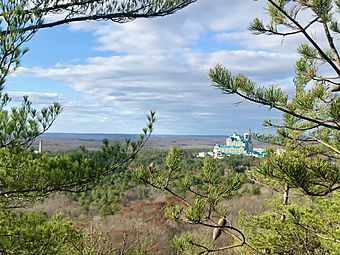Mashantucket Pequot Reservation Archeological District facts for kids
|
Mashantucket Pequot Reservation Archeological District
|
|

View over the reservation from Lantern Hill
|
|
| Lua error in Module:Location_map at line 420: attempt to index field 'wikibase' (a nil value). | |
| Location | Ledyard, Connecticut |
|---|---|
| Area | 1,638 acres (6.63 km2) |
| NRHP reference No. | 86001323 |
Quick facts for kids Significant dates |
|
| Added to NRHP | June 11, 1986 |
| Designated NHLD | April 12, 1993 |
The Mashantucket Pequot Reservation Archeological District is a special historical area in Ledyard, Connecticut. It covers about 1,638 acres (6.6 km2) of land. This land was once called Wawarramoreke by the Mashantucket Pequot Tribe. It is a very important place for understanding the history of the Pequot people.
This district is located in the northern part of Ledyard. It was officially recognized as a historic district in 1986. Later, in 1993, it was named a National Historic Landmark. This means it is a place of great national importance.
Contents
A Look at Pequot History
The Mashantucket Pequot Reservation Archeological District holds a big part of the land where the Pequot people lived for a long time. In 1666, the Connecticut Colony set aside about 3,000 acres (12 km2) for the Pequot tribe. This was meant to be their territory.
Over the next 200 years, the number of Pequot people became much smaller. Because of this, in 1856, the state reduced the size of their reservation. It became much smaller, only about 216 acres (0.87 km2).
Reclaiming Their Land
In the 1970s, the Pequot tribe started a legal case. They wanted to get their land back. This effort was successful! They eventually got back more than 2,000 acres (8.1 km2) of land. This was made possible by a special law passed by the United States Congress.
Finding Clues from the Past
After getting their land back, many archaeological studies began. Archaeologists are like history detectives. They dig up and study old objects to learn about people who lived long ago. These studies have found more than fifteen important historical sites on the reservation.
The tribe believes that the entire reservation is archaeologically important. This means that before any big building projects happen, the area must be carefully checked. This helps make sure no important historical clues are lost.
What Archaeologists Found
At these sites, archaeologists have found many interesting things. They discovered stone tools and quartz objects made by the native people. They also found various trade items from colonial times. Some of these items might be as old as the 1500s. These findings help us understand how the Pequot people lived and traded.
Life in Early Pequot Villages
The earliest village sites found don't show much about what houses looked like. However, by the 1700s, we know more about Pequot homes. Historical records show that the Pequots lived in two main types of houses.
- Some lived in traditional wigwam-style structures. These were often round or oval homes made from wood frames and covered with bark or mats.
- Others lived in European-style wood frame houses. This shows how the Pequot people adapted to new ways of living.
Farming and Village Layout
Archaeological evidence also shows how these villages were set up. They included large farm areas, sometimes 3 to 4 acres (1.2 to 1.6 ha) in size. These farmsteads were often surrounded by stone walls. These walls are important because archaeologists often find interesting objects near them. These objects give us clues about daily life in the past.

